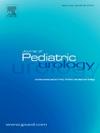输尿管镜检查治疗神经源性膀胱儿科结石病:一项单一机构病例对照研究。
IF 2
3区 医学
Q2 PEDIATRICS
引用次数: 0
摘要
导言:对于合并有增加结石形成和复发风险的疾病的儿童患者来说,输尿管镜检查(URS)尤其具有挑战性。据报道,神经源性膀胱(NGB)患者和/或不能行走的患者合并其他疾病的比例较高,患尿路结石的风险也特别高,感染和术后并发症的发生率也较高:报告NGB和/或行动不便的儿科结石病患者接受尿路造影术的结果,并将这些结果与没有这些合并症的患者进行比较:方法:使用一个经 IRB 批准的前瞻性单一机构登记处,回顾性地识别所有在 2012 年 7 月至 2021 年 7 月期间因结石病接受 URS 治疗的 18 岁以下患者(不包括膀胱结石)。患者分为两组:伴有或不伴有非卧床状态的 NGB 患者与所有其他患者(对照组)。对两组患者的基线人口统计学、术前放射成像、术中细节和术后结果(包括 30 天并发症)进行了汇总和比较。术前造影显示,NGB 患者的结石数量(3 vs 2,p = 0.003)和总结石量(15 mm vs 9 mm,p = 0.009)明显高于非 NGB 患者。NGB 患者的手术时间明显更长(86 分钟对 60 分钟,p = 0.002),分阶段手术的需求增加,住院时间延长(1 天对 0 天,p 结论:NGB 患者的手术时间明显更长(86 分钟对 60 分钟,p = 0.002),分阶段手术的需求增加,住院时间延长(1 天对 0 天,p = 0.003):研究结果表明,神经源性膀胱的儿科患者可以安全有效地进行尿路碎石术。手术后 30 天内感染并发症的风险增加,因此需要为这类患者制定谨慎的术前和术后抗生素护理计划。本文章由计算机程序翻译,如有差异,请以英文原文为准。
Ureteroscopy for stone disease in pediatric patients with neurogenic bladder: A single institution case-control study
Introduction
Ureteroscopy (URS) for urolithiasis in pediatric patients may be particularly challenging for patients with co-morbidities that increase the risk for stone formation and recurrence. Patients with neurogenic bladders (NGB) and/or patients that are non-ambulatory are reported to have higher rates of additional comorbidities and a particularly increased risk of developing urolithiasis, and higher rates of infections and post-operative complications.
Objective
To report outcomes of URS for stone disease in pediatric patients with NGB and/or non-ambulatory status and compare these outcomes to patients without these co-morbidities.
Methods
An IRB-approved prospective single institutional registry was used to retrospectively identify all patients under 18 years of age who underwent URS for stone disease between July 2012 and July 2021, excluding bladder stones. Patients were categorized in two groups: patient with NGB with or without non-ambulatory status versus all other patients (control). Baseline demographics, pre-operative radiologic imaging, intra-operative details, and post-operative outcomes including 30-day complications were aggregated and compared between the two groups.
Results
275 URS in 198 patients were performed during the study period, and 49 (18 %) of these were performed on patients with NGB. Pre-operative imaging showed significantly higher number of stones (3 vs 2, p = 0.003) and larger total stone burden in patients with NGB than those without NGB (15 mm vs 9 mm, p = 0.009). Patients with NGB had a significantly longer length of procedure (86 vs 60 min, p = 0.002), increased need for staged procedures, increased length of stay (1 vs 0 days, p < 0.001), and increased use of an extended duration of antibiotics prior to the procedure (<0.001). There was no difference in need for passive dilation, stent placement, or other intra-operative parameters. There was no statistical difference in the incidence of 30-day complications between the two groups post-operatively. However, there was a higher incidence of febrile UTIs (8.2 % vs 1.3 %, p = 0.021) in patients with NGB and a lower incidence of pain related complications (0 % vs 9.3 %, p = 0.032). Patients with NGB had a higher incidence of requiring ipsilateral URS for recurrent stone disease within a year of surgery (34.6 % vs 18.9 %, p = 0.01).
Conclusion
The results show that URS for urolithiasis can be done safely and effectively in pediatric patients with neurogenic bladders. The increased risk of infectious complications within 30 days of surgery warrants careful pre- and post-operative antibiotic care plan for this patient population.
Summary table 1. Post-operative outcomes for patients with and without neurogenic bladder undergoing URS.
| Empty Cell | Neurogenic Bladder | Control | p-value |
|---|---|---|---|
| 49 | 226 | ||
| Length of Stay (Days), median (IQR) | 1 (0, 3) | 0 (0, 0) | <0.001 |
| 30-day Complication | 9 (18.4 %) | 35 (15.5 %) | 0.667 |
| Clavien Dindo Classification | 0.002 | ||
| Grade I | 0 (0 %) | 21 (60.0 %) | |
| Grade II | 9 (100 %) | 11 (31.4 %) | |
| Grade IIIb | 0 (0 %) | 3 (8.6 %) | |
| Complication Type | |||
| Febrile UTI | 4 (8.2 %) | 3 (1.3 %) | 0.021 |
| Afebrile UTI | 1 (2.0 %) | 0 (0.0 %) | 0.18 |
| Stent Malfunction | 1 (2.0 %) | 0 (0.0 %) | 0.18 |
| Stent Dislodgement | 0 (0.0 %) | 2 (0.9 %) | 1.00 |
| Pain | 0 (0.0 %) | 25 (11.1 %) | 0.011 |
| Hematuria | 1 (2.0 %) | 0 (0.0 %) | 0.18 |
| Post-Op Fever | 4 (8.2 %) | 5 (2.2 %) | 0.056 |
| Other | 2 (4.1 %) | 7 (3.1 %) | 0.66 |
| Stone Free Rate (SFR) | 63 % | 68 % | 0.465 |
| Ipsilateral Stone Surgery within 1 year | 18 (36.7 %) | 43 (18.9 %) | 0.012 |
求助全文
通过发布文献求助,成功后即可免费获取论文全文。
去求助
来源期刊

Journal of Pediatric Urology
PEDIATRICS-UROLOGY & NEPHROLOGY
CiteScore
3.70
自引率
15.00%
发文量
330
审稿时长
4-8 weeks
期刊介绍:
The Journal of Pediatric Urology publishes submitted research and clinical articles relating to Pediatric Urology which have been accepted after adequate peer review.
It publishes regular articles that have been submitted after invitation, that cover the curriculum of Pediatric Urology, and enable trainee surgeons to attain theoretical competence of the sub-specialty.
It publishes regular reviews of pediatric urological articles appearing in other journals.
It publishes invited review articles by recognised experts on modern or controversial aspects of the sub-specialty.
It enables any affiliated society to advertise society events or information in the journal without charge and will publish abstracts of papers to be read at society meetings.
 求助内容:
求助内容: 应助结果提醒方式:
应助结果提醒方式:


